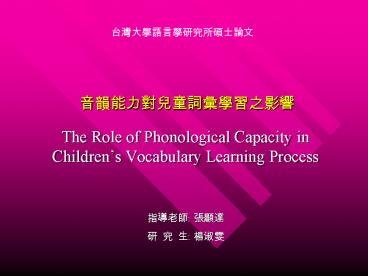The Role of Phonological Capacity in Children - PowerPoint PPT Presentation
Title:
The Role of Phonological Capacity in Children
Description:
Research question. 1) Between speech perception and speech production, which component is more ... New word production task: repeating minimally ... Results: ... – PowerPoint PPT presentation
Number of Views:31
Avg rating:3.0/5.0
Title: The Role of Phonological Capacity in Children
1
??????????????
??????????????
- The Role of Phonological Capacity in Childrens
Vocabulary Learning Process - ???? ???
- ? ? ? ???
2
Introduction
- Young children display a rapid growth in
vocabulary (Smith, 1926 Templin, 1957 Carey,
1978). - Word learning essentially involves a mapping
between the sound patterns (phonological
representations) and the meanings (semantic
representations) of individual words. - Fast-mapping process (Carey Bartlett, 1978)
- Nonlinguistic strategies
- Linguistic constraints
3
- Mapping on the phonological end (Bishop, 1997)
permanent lexical representation
long-term storage
phonological trace in STM
short-term storage
phonological segmentation
sequence of phonemes
4
- Baddeleys working memory model (Gathercole
Baddeley, 1993)
phonological LTM
rehearsal process
phonological STM
speech perception
5
Purpose
- This study aims to investigate the role of
phonological capacity in childrens vocabulary
learning process. - Phonological capacity
- Production
- Discrimination
6
Research question
- 1) Between speech perception and speech
production, which component is more important for
the success of word learning? - 2) Which kind of word is easier to be learned?
The one that can be discriminated easily, or the
one that can be produced. - 3) Other factors, such as phonological memory and
vocabulary knowledge, are involved in the word
learning process. What are their relative
contributions in the word learning process?
7
Method
- Subjects
- Total number 80 preschool children
- Mean age 43 (3050)
- Sex equal numbers of boys and girls
- Group K1 and K2
- Four experimental tasks
- Phonological capacity tasks
- Phonological memory task
- Vocabulary task
- Word learning task
8
Tasks on phonological capacity
- Picture naming task naming pictures of familiar
objects - New word production task repeating minimally
contrastive novel words - For example
- New word discrimination task choosing proper
- referent of the target sound
9
- Materials (adopted from Cheung, 2000)
10
- Results
- Childrens performance in two age groups
- The result is different from that of Cheung
Hsus study (2000).
11
The Task on phonological memory
- Repeating the nonwords orderly.
- For example ba3gan1 zhau1dai3 ku4shang4
- Materials (adopted from Hu, 1999)
12
- Results
- The mean score was 20.48 (Max. 36), with the
mean accuracy of 56.9. - Childrens performances in two age groups
13
The task on vocabulary
- Materials Peabody Pictures Vocabulary
Test-Revision (Chinese version Lu Liu, 1988) - For example
14
- Results
- The mean score was 30.88.
- Childrens performances in two age groups
15
The task on word learning
- Materials
- The example of picture stories
????????????????? ??????,??????????
???????????????? ?????????,???????????
16
- Scripts of the shovel story
- The comprehension test
17
- Sound category
Perception
Average
Average
Production
18
- Novel words
19
- Results
- The mean score was 12.68 (Max. 32), with the
mean accuracy of 39.6, higher than the chance
level. - Childrens performances in two age groups
20
Syntheses
- Between phonological capacity and word learning
- On individual subjects
21
- Between phonological capacity and word learning
- On word items
The result of original design
The recomputed result
22
- Correlational analyses
- A stepwise multiple regression
23
Conclusion
- The ability to comprehend the target labels is
plays a major role in the word learning process,
while the ability to produce the target labels is
important when contextual cues are limited. - The phonological form of target words does not
affect the word learning process. - Vocabulary size is crucial for learning new
words, while the role of phonological memory does
not appear to be important in this model.
24
- Thanks for your attention






























